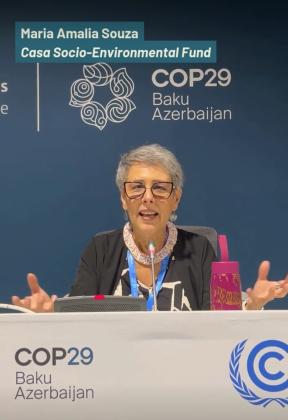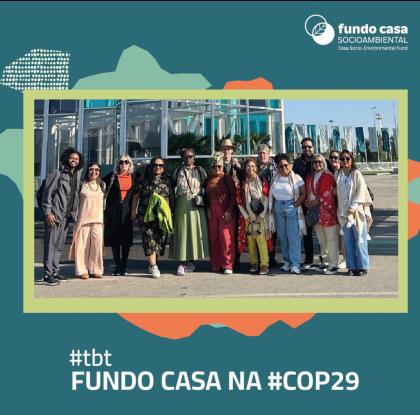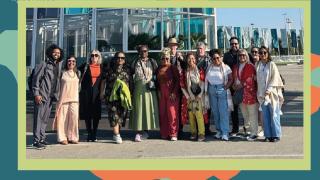The Climate Crisis is Global: Insights from COP29 and Preparing for COP30
Featuring Maria Amália Souza, Founder and Head of Strategic Alliances & Partnerships at Casa Socio-Environmental Fund.
How has the Baku COP differed from previous COPs?
Most people skipped Baku COP because the real focus is COP30 in Brazil. That meant it was much smaller than usual, and everything was more concentrated. Still, a lot was going on, and for some of the unofficial discussions related to climate finance, we had more access to decision-makers more easily.
The goal of Casa Fund to attend —and to bring a delegation of community and social movement leaders made up of Indigenous peoples, Afro-descendent movement leaders, forest dwellers that coordinate regional organizations, etc — is twofold: (1) to allow these communities, the most affected by climate change and its consequences (as well as those with the best solutions), to understand the level of government and funders’ conversations that directly affect their territories, and (2) to enable their access, and voice, in conversations that directly affect their lives.
This is the third COP where Casa Fund brings a delegation of approximately seventeen people, including some of our young staff with diverse experience in the funding we make across our themes and territories.
How is Civil Society empowered by dialogues happening at COP29?
The leaders the Casa Fund brings come from diverse territories and backgrounds. They represent large constituencies of the most important guardians of our biodiversity and climate-regulating biomes. At COPs, these leaders are mentioned as the most important people for solutions. But, in the overwhelming majority of cases, they are only the object of conversations without any say in the decisions made for and about them. When we bring leaders to COPs, we prepare them over several webinars during the preceding months; they come ready to intervene.
As well-recognized leaders among Brazil's civil society, they also secure spots in panels besides the ones we promote ourselves. They create a wave of local voices that permeate many conversations. The relationships formed during COPs often carry on after the conference as well.

What did you feel were the successful outcomes of COP29?
To give an idea, our delegation alone was made up of leaders of Indigenous and Quilombola territorial funds, an Amazon-wide long-standing social movements network, youth involved in the discussions of youth for climate, senior advisors, experts in climate change and public policies–who were mentors of the webinars and leaders during the event-myself as the founder and head of strategic alliances and partnerships, our Executive Director, and the executive coordination of the Socio-Environmental Funds of the Global South Alliance.
At COP29 , we connected with other Brazilian funds and members of the Global South Alliance from Latin America, Africa, and Asia. All of us combined spoke in at least fifty panels. We participated in more than one hundred events and different negotiation spaces, including having access to the delegation of Brazilian authorities represented by Brazil’s Vice-President, ministers of Environment, Indigenous Peoples, Human Rights, and Racial Equity, as well as the Governor and delegation of the state of Pará, that will hold COP30 in Brazil. The Brazil delegation at COP29 was one of the largest of any country.
This preparation was crucial to position Brazilian civil society as a key player in the next COP, where major participation is sure to happen. Here is a short video I made explaining the reason we attend COPs and why we take our partners along.
What was one outcome or conversation that you felt was missing from COP29?
I chose to attend some spaces that were talking about investments, supposedly directed to adaptation, resilience, maintaining forest standing, and bioeconomy (which civil society prefers to call the “economy of socio biodiversity,” with the understanding that all these natural spaces were carefully planted and tended by local communities, so the social and cultural aspects of keeping them alive are completely intertwined).
Two events I attended at the Climate Action Innovation Zone, one hosted by IE University - Sovereign Impact Initiative and the other by the International Institute for Environment and Development, respectively, had similar topics. The first called for “bringing together global investors from the Global South and North to strategize on bridging climate and SDG financing gaps and aiming to produce high-level recommendations ahead of 2025 UN Conference on Financing for Development in Sevilla.” The second was to “explore innovative financing options for climate adaptation, from safeguarding communities to protecting business value against extreme climate impacts.”
Both were in the format of roundtables, with obviously high-level players in the investment sector. I expected that both sessions, from the descriptions, should have included the impact of investments on the real lives of the planet’s guardians and their role in the solutions. Still, except for what I brought into the discussions, these conversations were far from what seemed to be their calls. I attended another private event that promised the same kind of conversation, and again, nothing. Investors don’t realize that any investment that doesn’t deal with the planet’s polycrisis is doomed to fail. They talk about what is bankable, investment risks and how to de-risk them, and other financial jargon that doesn’t get even close to the reality of how to secure the protection of the most important, biodiversity-rich, and climate-regulating biomes.
The philanthropy field will need to tackle these conversations at some point, or risk COP30 being, again, a retrocess, like the official negotiations in Baku clearly were.
What conversations would you like to have at COP30? What should grantmakers pay special attention to?
Speaking as a local philanthropy entity specialized in funding the most important community-led issues that affect climate change at scale, I believe it is fundamental that philanthropic sectors across themes unite more. I feel our sector is dispersed and confused about what is at stake for places that hold the important biomes of the planet. Funding and cooperation from philanthropy continues to be concentrated in the hands of Global North structures swelling day by day. But, these structures deliver less and less due to the simple fact that, at this point in the evolution of local problems, only local solutions executed by local actors can make a real difference.
To desire change while continuing to do things the same way is not the answer. While business as usual continues, structures like Casa Fund have spread across the planet for the last 20+ years. We have built solid, transparent, and accountable infrastructure to receive and distribute large amounts of funding at a scale that is impossible to do from the outside, with the best intentions. At the same time that the discourse is to fund local solutions, the money is still going to global players at an absurdly disproportionate rate. Just take a look at one of our collaborations, the Alianza Socioambiental Fondos del Sur, to see how much reality has changed in our regions. Then look at where large climate funding is landing, and the scenario is clear.
The majority of resources continue to be managed by INGOs (international non-governmental organizations). Due to easy access to money from players of the Global North, a lot of money is going to newly invented structures that claim to land resources locally. However, these structures end up consuming most of the money in expensive operations, while hindering local, much more efficient and tested solutions like ours and those of our partners. This is the kind of discussion I see as crucial if things are to change in the short time we need them to before it becomes irreversible.

Tell us about the conversations from COP16 (2024 United Nations Biodiversity Conference) and if the Casa Fund announced any initiatives you’d like to elevate.
I was not at COP16, but we had representatives there. In summary, the experience was very positive because the small size helped to build stronger relationships and participate in more in-depth discussions, including with funders. One positive result was that the Afro-descendant communities were recognized as traditional communities and keepers of biodiversity, which they weren’t before.
It was Casa Fund’s first attendance, and launching such a large and important call for proposals there brought a lot of attention to our work and capacity to manage and distribute funding at scale. We are positioning ourselves, not only on biodiversity issues, but all aspects of environmental protection and sustainability. We are positioning ourselves as a structure that can become a re-grantor—a recipient of funding comparable to what reaches Global North structures—with the advantage that we are locals that operate in local currencies, and are capable of disbursing, monitoring, evaluating and building lessons that the field can benefit from at an incomparable scale.
In your opinion, did COP29 further opportunities for Grantmakers to close the finance gap? If yes, how so, and in what ways?
I don’t think COP29 took the financial aspect seriously enough at all, not in the official decisions and not from international funders. To close the gap, as I mentioned above, serious modifications in treatment and relationship with Global South structures like ours have to happen. And for that, serious conversations that bring us to the table are the only way. Almost daily, I’m approached by a new fund from the Global North, possessing new funding in pretty large amounts, wanting to hear what we think about their new approaches and what advice we have.
But we don’t say what they hope to hear - a list of groups they can fund directly, for example. We could do that; there are a reasonable number of them, but they are infinitely less than the scale that needs to happen to change things in the depth they need to be changed. To do that, more communities need to be funded, the ones that are the most vulnerable and excluded and that have been “holding the fort” of protecting important territories for the future of life on Earth. And that number of grants, in local currencies, built to the scale of the demand we receive, is the only way to make real change. So, we will never lie when asked about what it takes to really change things. This is what is needed.
Brazil alone has a large infrastructure of local funds that collaboratively tackle many aspects of social exclusion and environmental injustice, organized under the Comuá Network, making millions of dollars in grants to thousands of communities every year. The Alianza covers 50 countries of the Global South already. We have all that is needed; what we need is to break these silos that Northern philanthropy has built around itself, that keep it from renewing and being more efficient for the sake of humanity having a chance of a future on this Earth.
This interview has been edited for length and clarity.
